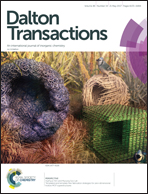The effects of introducing sterically demanding aryl substituents in [Cu(N^N)(P^P)]+ complexes†
Abstract
The syntheses and characterizations of six [Cu(N^N)(POP)][PF6] and [Cu(N^N)(xantphos)][PF6] compounds (POP = bis(2-(diphenylphosphino)phenyl)ether, xantphos = 4,5-bis(diphenylphosphino)-9,9-dimethylxanthene), in which N^N is a bpy ligand (1-Naphbpy, 2-Naphbpy, 1-Pyrbpy) bearing a sterically hindered 1-naphthyl, 2-naphthyl or 1-pyrenyl substituent in the 6-position, are reported. Single-crystal structure determinations of five complexes confirm a distorted tetrahedral environment for copper(I) and a preference for the N^N ligand to be oriented with the sterically-demanding aryl group being remote from the (C6H4)2O unit of POP or the xanthene ‘bowl’ of xantphos. The angle between the ring planes of the bpy range from 5.8 to 26.0° and this is associated with interactions between the aryl unit and the phenyl substituents of the P^P ligand. In solution at room temperature, the complexes undergo dynamic behaviour which has been investigated using variable temperature 2D NMR spectroscopy. The [Cu(N^N)(xantphos)]+ complexes exist as a mixture of conformers which interconvert through inversion of the xanthene bowl-shaped unit; the preference for one conformer over the other is significantly changed on going from N^N = Phbpy to 1-Pyrbpy (Phbpy = 6-phenyl-2,2′-bipyridine). The electrochemical and photophysical properties of the [Cu(N^N)(POP)][PF6] and [Cu(N^N)(xantphos)][PF6] compounds are presented; the compounds are orange emitters but the introduction of the 1-naphthyl, 2-naphthyl or 1-pyrenyl substituents result in poor photoluminescence quantum yields.
![Graphical abstract: The effects of introducing sterically demanding aryl substituents in [Cu(N^N)(P^P)]+ complexes](/en/Image/Get?imageInfo.ImageType=GA&imageInfo.ImageIdentifier.ManuscriptID=C7DT00782E&imageInfo.ImageIdentifier.Year=2017)


 Please wait while we load your content...
Please wait while we load your content...